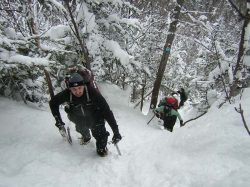|
Mount Washington (6288') Winter Lion Head Route - March 15, 2005 |
||
|
After many years of hiking east coast and western mountains I decided it was time to branch out a bit and try some winter mountaineering. After searching around I found the perfect hike to indoctrinate me into the different world of winter hiking: a winter ascent of Mount Washington in the New Hampshire Presidential Range. Renowned for it’s record breaking poor weather (wind speed of 231 mph and wind chills of 50 below zero!) I knew that climbing Mount Washington was a serious endeavor requiring appropriate equipment and preparation. I also chose to be guided on the route by the mountaineering specialists at Eastern Mountain Sports. EMS guides are extremely knowledgeable about the route, weather, equipment and techniques necessary to make a winter ascent of Mount Washington successful and safe. The trip planning started several months ago with the necessary accumulation of all new specialized winter hiking gear. Super-warm thermal layers, jackets, shells and insulated pants came streaming in from outfitters all over the country. With the possibility of wind-chills reaching 50 below zero it was necessary to assure that every inch of skin would be protected against frostbite. Snow goggles, an adze (a mountaineering-axe used for chopping steps and self-arresting), gaiters, plastic boots and crampons, insulated water containers, etc., would all be new equipment that I’d never had to use before in my normal hiking. I flew into Portland, Maine on Monday, March 14th and drove my rental car the 70 miles into North Conway, New Hampshire. This trip was going to be a bit of a “mad dash” since I was unable to secure more than three days off of work. Monday and Wednesday were going to be my travel days and Tuesday was the planned climbing day. After checking into my hotel in North Conway I drove down to the EMS Climbing School where I was introduced to the two guides that were assigned to our group of clients. Our group consisted of four people: a father and son, Stewart and Steve, and a woman named Cindy and me. Normally a group of four would likely be guided by a single EMS guide, but a second guide was joining our climb to film footage for EMS promotional purposes. They gave me some general guidance on what to wear and what to bring, fitted my plastic climbing boots and crampons and told me to show up on Tuesday morning at 7AM. Monday night I turned in early so that I’d be well rested for the hike on Tuesday. Checking the summit conditions on the internet I saw the winds on the summit were around 40 mph with a forecast for up to 70 mph by morning. Light snow was forecast and I figured we’d be in for typical Mt. Washington weather conditions. Tuesday morning dawned with grey skies and some very light snow flurries. I choked down some mini-donuts on the way over to EMS and after a few minutes squaring away all our equipment we loaded up and drove over to Pinkham Notch which would be the starting point for our hike. The area had received a significant amount of snow just a couple days prior to our hike, so conditions were going to be perfect for our hike. The avalanche danger was forecast to be in the middle of the danger range, but the Lion Head Winter Route is specifically designed to avoid avalanche prone areas. Click thumbnail images to open! Our guides Joe (top), who is head of the North Conway EMS Climbing School and the mountain ninja guide (and super strong climber!) Tim (bottom):
|
Our party (minus Tim who was taking the picture) at the Pinkham Notch trailhead (left to right Cindy, Steve, Stewart, me, Joe): Our trail would take us up gently at first, then through a very steep section until breaking out of the tree-line toward Lion Head. After Lion Head a steady moderate slope winds up to the summit: Heading up the wide trail the snow was compacted nicely and we used trekking poles for the first mile or so since the grade of the trail was relatively mild. Once we started climbing into the woods the trail steepened and we stopped at a small clear hill area so that Joe and Tim could teach us the proper techniques for self-arresting using the adze. Taking turns sliding down the hill we practiced how to flip over while sliding and bury the head of the ice axe into the snow to stop our descent. The wide part of the trail accessible to the Snow-Cat: Me at the “self arrest” training area: After a mile or so the trail branched off into the woods and we left the packed down forest road for a real backcountry trail. We stopped briefly to collapse our trekking poles, strap crampons to our boots and pull out our adzes. At every brief stop we would make (which weren’t very frequent) our guide Joe encouraged us to quickly down food and water to keep our energy and hydration up. Eat and drink, eat and drink, eat and drink, became the mantra whenever we weren’t moving. With our crampons on and our ice axes plunging into the snow to stabilize us we started a very steep climb up through the woods. In no time I was sweating (despite Joe’s insistence that we avoid that) with the effort. The hiking in parts turned to outright climbing with us pulling and clawing our way up some very steep segments. The crampons and ice axe were pivotal in maintaining our footing and balance during the steepest parts.
Click here to continue to Page 2
|
|






